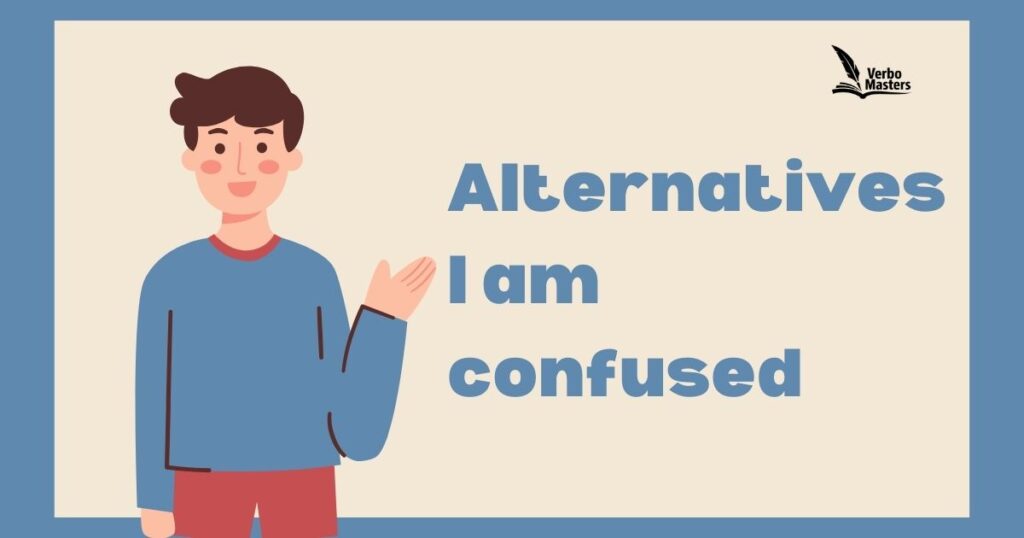When faced with uncertainty or a lack of clarity, it’s important to express your feelings in a professional manner. Instead of simply saying “I’m confused,” there are various ways to communicate this in a more polished way. Whether it’s in a business setting, during a meeting, or in a written communication, using the right language can help convey your thoughts effectively.
This approach ensures that you remain professional while clearly expressing the need for more information or guidance. Here are 150 professional way to say I am confused in different contexts. Let’s explore these alternatives that keep communication clear and respectful.
Alternatives I am confused

150 professional ways to say I am confused:
- I’m unclear on this point.
- I’m not sure I fully understand.
- Could you clarify that for me?
- I’m having trouble grasping this.
- I’m not following the logic here.
- I’m uncertain about the details.
- I’m having difficulty comprehending this.
- I’m not clear on the next steps.
- Could you help me understand this better?
- I’m unsure about this concept.
- I’m having trouble processing the information.
- I need a little more clarification on this.
- This part is unclear to me.
- I’m not entirely sure what’s being asked.
- I’m a bit lost on this.
- I’m struggling to see the connection.
- I don’t fully understand what’s being discussed.
- I’m not quite sure how to interpret this.
- Could you break this down for me?
- I’m having some difficulty following along.
- Could you please explain that again?
- I’m having a hard time understanding the context.
- This is a bit beyond me at the moment.
- I’m unclear on the requirements.
- Could you elaborate on that point?
- I’m not sure I’m on the same page here.
- I’m uncertain about how to proceed.
- I’m not entirely sure about the approach.
- I’m not sure what you’re trying to convey.
- I’m a bit confused on how we got here.
- Could you clarify your position on this?
- I’m not quite clear about your suggestion.
- I’m uncertain about the specifics of this.
- I’m not entirely certain how this works.
- I’m not sure I understand the full picture.
- I don’t quite understand the details.
- I’m not sure I’m following the discussion.
- This concept is a bit confusing for me.
- I’m not completely clear on the expectations.
- Can you explain this part again for me?
- I’m a little bit confused on that point.
- I’m having trouble wrapping my head around this.
- I need more clarification to proceed.
- I’m unclear about what you mean by that.
- I’m unsure what you’re asking.
- I’m not fully clear on the process.
- I’m still unsure about the final decision.
- I’m not entirely certain of your perspective.
- I’m not sure I’ve got the whole picture.
- Could you give me more context on that?
- I’m having a bit of trouble understanding this.
- I’m not entirely sure how to interpret that.
- I’m unclear about the next steps here.
- I need more information to fully understand this.
- This part seems a little bit fuzzy to me.
- I’m still unclear about some details.
- I’m struggling to make sense of this.
- I’m uncertain how to approach this situation.
- Could you expand on that a bit more?
- I’m not completely clear on your intentions.
- I’m not sure how this applies to the situation.
- I don’t fully grasp the meaning behind this.
- I’m a bit uncertain about the implications.
- I’m not following the flow of the conversation.
- Could you clarify what you mean by that?
- I need more insight to fully understand this.
- I’m unsure about the direction we’re headed.
- I’m not certain I’m grasping the concept.
- I’m not entirely clear on how this works.
- Could you give me a bit more detail on that?
- I’m not entirely sure what you’re referring to.
- I’m having some uncertainty about this.
- Could you elaborate on that aspect?
- I’m not quite sure what you mean by that.
- I need a clearer explanation to understand.
- I’m unsure of the context behind this.
- I’m a bit confused by your reasoning.
- I’m not sure I completely understand the solution.
- Could you please explain that part again?
- I’m struggling to keep up with this.
- I’m not entirely sure I’ve got the right understanding.
- I’m unclear on the details of this matter.
- Could you walk me through this again?
- I’m unsure how this all connects.
- I’m still trying to fully comprehend this.
- I’m uncertain about the best way to approach this.
- I’m not sure I fully understand your point.
- I’m having difficulty grasping the full picture.
- I’m not sure I’m clear on your instructions.
- I’m still processing the information.
- I don’t completely understand the implications.
- I’m unclear about the overall objective.
- Could you give me more details to help clarify?
- I’m not quite sure how to proceed with this.
- I need more context to understand this fully.
- I’m a bit lost on how we arrived at this conclusion.
- Could you explain that in a different way?
- I’m unsure of how this works in practice.
- I’m unclear about the impact of this.
- I’m struggling to follow the steps.
- I’m not entirely certain what you’re getting at.
- Could you clarify your thought process here?
- I’m unsure about the expected outcome.
- I’m not sure how to interpret that comment.
- I’m having trouble understanding how to move forward.
- I need more clarity to make a decision.
- I’m unclear on the importance of this detail.
- I’m not sure how this fits into the larger picture.
- Could you explain what you mean by that phrase?
- I’m not entirely certain about the reasoning behind this.
- I’m having a hard time making sense of this.
- I’m unsure how this aligns with the plan.
- I’m not sure I’m interpreting this correctly.
- I’m not entirely sure where we are with this.
- I’m struggling to piece this all together.
- I need further explanation to comprehend this fully.
- I’m uncertain about how this affects the overall outcome.
- I’m not entirely clear on the purpose of this.
- Could you please provide more context on this point?
- I’m unclear about the intended result here.
- I’m unsure of how this decision will impact things.
- I’m not completely certain about how this will unfold.
- I’m still trying to get my head around this.
- I’m uncertain how this piece fits into the whole.
- I’m unclear about the reasoning behind this choice.
- Could you help me clarify that idea further?
- I’m unsure about the logistics of this.
- I’m not certain I understand all the details.
- I’m a bit unsure about how to handle this.
- I’m unclear about the role of this in the overall project.
- I’m having difficulty following the steps to resolve this.
- I’m unsure about how to make sense of these results.
- I’m not completely sure how this will play out.
- I’m struggling to understand how we got to this point.
- I’m not sure I fully understand the task at hand.
- Could you explain how this decision impacts me?
- I’m unsure of the next course of action.
- I’m having trouble following the strategy here.
- Could you explain that step-by-step for me?
- I’m not clear about the rationale for this.
- I need more information before I can make a conclusion.
- I’m still not clear on the expected outcome.
- I’m unsure about the implications of this choice.
- I’m not sure what you’re expecting from me here.
- I’m unclear about the connection between these two points.
- Could you elaborate on how this should be handled?
- I’m having trouble visualizing how this will work.
- I’m unclear about the criteria for this decision.
- I’m unsure about the potential risks here.
- Could you clarify the impact of this on the project?
These alternatives will help you express confusion professionally and clearly in any situation!
FAQs
What does it mean to express confusion professionally?
It means communicating that you don’t understand something clearly without sounding negative or unprepared. The goal is to ask for clarity while maintaining a respectful and constructive tone.
When should I say I’m confused in a professional setting?
You should speak up as soon as you realize you’re not following along or need more information to do your job effectively. It’s always better to ask than to stay silent and risk making mistakes.
Why is it important to use professional language when confused?
Using professional language shows maturity and respect. It helps maintain good communication, avoids misunderstandings, and keeps the conversation productive.
Can I say I don’t get it at work?
While honest, “I don’t get it” may come off as too casual or blunt. It’s better to say something like, “Could you walk me through that again?” or “I’d appreciate a bit more detail.”
How can I ask for clarification without sounding unprepared?
Use polite and direct phrases like “Could you clarify this part for me?” or “I want to make sure I understand correctly.” It shows you’re engaged and eager to learn.
Is it okay to admit confusion in a meeting?
Absolutely. Just be concise and respectful. Say something like, “I’m not sure I’m following—could you elaborate a bit?” This opens the door for helpful clarification.
What’s the best way to follow up if I didn’t understand something?
You can follow up with a quick message or email saying, “I wanted to revisit something we discussed—can we go over it again when you have a moment?” It shows initiative and professionalism.
Should I pretend to understand to save face?
No, pretending can lead to bigger problems down the line. Asking thoughtful questions shows confidence and helps ensure you’re doing your best work.
What tone should I use when expressing confusion?
Stay calm, respectful, and curious. Avoid sounding frustrated or negative. Use friendly language that encourages further explanation.
How can I improve my communication when confused?
Practice active listening, take notes, and ask follow-up questions. Don’t be afraid to speak up and confirm your understanding to stay on track.
Conclusion
Feeling confused is completely natural, especially in fast-paced or complex environments. The key is knowing how to express that confusion in a respectful and professional way. It helps others support you without making things awkward or uncomfortable.
Using clear, polite language builds trust and shows you’re engaged, not clueless. Asking for clarification doesn’t make you look weak—it shows you’re committed to understanding. In the end, thoughtful communication always leads to better teamwork and results.

I’m John Smith, a language enthusiast dedicated to helping writers, students, and professionals master the art of clear and effective communication. Whether you’re looking for grammar tips, writing guides, or common mistake corrections, you’ll find valuable insights to improve your language skills. Let’s make grammar simple and fun!

